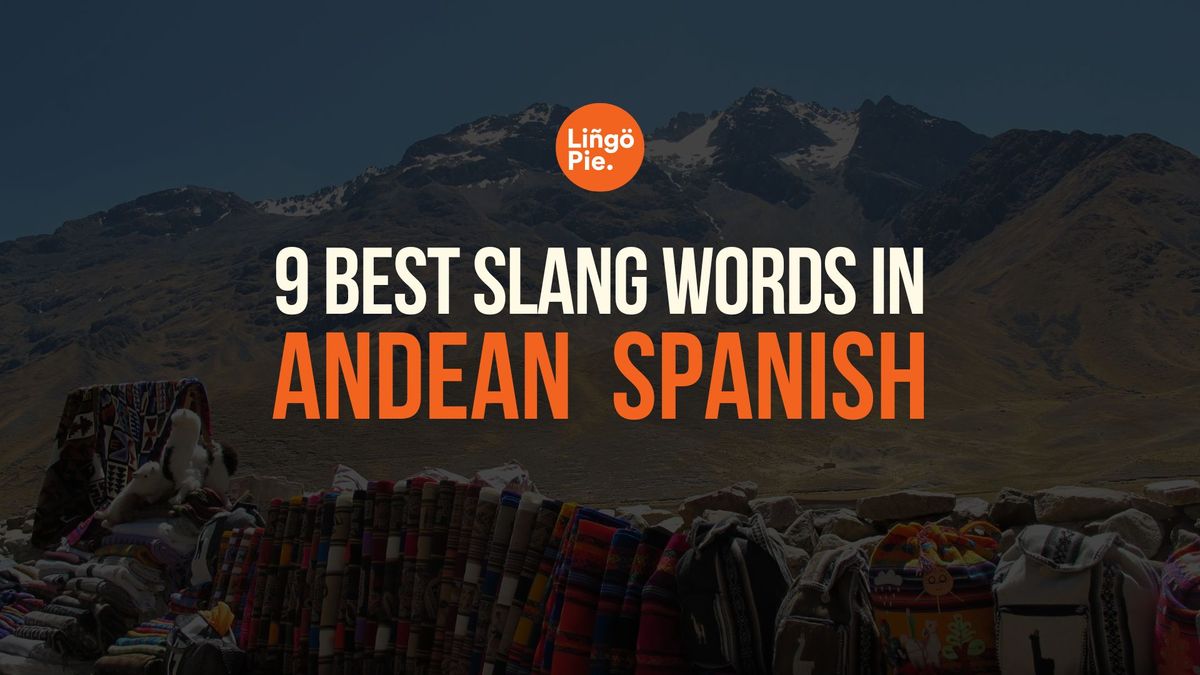Did you know there's a Spanish dialect that sounds like it's got a dash of ancient Inca mixed in? Yep, we're talking Andean Spanish!
As a native Spanish speaker from Peru, I understand how learners can be intrigued by the diverse dialects across Latin America, with Andean Spanish being one of the most prevalent.
Well, not just prevalent...
In fact, Andean Spanish isn't just some tiny local thing. We're talking about a major Spanish variant that's alive and kicking all the way from Colombia down to Bolivia and northern Chile. That's a huge chunk of South America!
What makes it so special? It's like Spanish and indigenous languages (think Quechua and Aymara) had a linguistic love child. The result? A Spanish that tells the story of centuries of cultural blending right in its grammar and vocab.
But don't worry, I'm not here to bore you with a history lesson. Instead, I'm going to teach you some real-deal Andean slang that'll have you sounding like a local in no time.
Sidenote: You can read more posts from our slang series here:

Common Slang Words In Andean Spanish

Here are some common slang phrases in Andean Spanish, reflecting the regional linguistic flavor. These phrases also highlight the rich blend of Spanish and indigenous influences in Andean Spanish, giving it a unique regional character.
Chévere
Origin: Likely African, via Venezuela
Usage: Widespread in Colombia, Ecuador, Peru
Meaning: "Cool" or "awesome"
Example: "¡Qué chévere tu nuevo celular!" (How cool is your new phone!)
Chamba
Origin: Possibly Quechua "champa" (tangled)
Usage: Primarily Peru and Ecuador
Meaning: "Job" or "work"
Example: "Tengo que ir a mi chamba." (I have to go to my job.)
Ñaño/a
Origin: Quechua "ñaña" (sister)
Usage: Mainly Ecuador
Meaning: Affectionate term for sibling or close friend
Example: "¿Qué planes tienes, ñaño?" (What plans do you have, bro?)
Jato
Origin: Likely Quechua "hatu" (market)
Usage: Mostly Peru
Meaning: "House" or "home"
Example: "Vamos a mi jato a ver una película." (Let's go to my place to watch a movie.)
Pata
Origin: Quechua "pata" (edge or border)
Usage: Peru and Bolivia
Meaning: "Friend" or "buddy"
Example: "Ese pata es mi mejor amigo." (That guy is my best friend.)
Chompa
Origin: English "jumper"
Usage: Peru and Bolivia
Meaning: "Sweater"
Example: "Hace frío, ponte tu chompa." (It's cold, put on your sweater.)
Pucha
Usage: Throughout the Andean region
Meaning: Mild exclamation of frustration or surprise
Example: "¡Pucha! Se me olvidó la billetera." (Darn! I forgot my wallet.)
Achachay
Origin: Quechua onomatopoeia for shivering
Usage: Ecuador
Meaning: Expression of feeling cold
Example: "¡Achachay! Está helando afuera." (Brrr! It's freezing outside.)
Cholo/a
Origin: Possibly Aztec/Mayan term for "dog" or "mixed-breed"
Usage: Pan-Andean, but the meaning varies significantly
Meaning: Can refer to a person of mixed heritage or informally as "buddy"
It's important to note that while these terms are common in Andean Spanish, their usage and exact meaning can vary between countries and even regions within countries. The dynamic nature of language means that slang is constantly evolving, influenced by factors such as age, social group, and local culture.

What Countries Make Up The Spanish Spoken in the Andean Region?
Andean Spanish wouldn’t be what it is today without the influence of these regional countries.
Peru
From the earliest days of Spanish colonization, Peru held a privileged position due to its abundant mineral resources and rich indigenous civilizations, notably the Inca Empire.
Why?
This region became a focal point for an intense clash of languages.
Not only that: The interaction between Spanish and Quechua gave rise to many words now common in Peruvian Spanish, such as "choclo" (corn), "chupe" (a type of stew), and "chompa" (sweater).
Bolivia
Bolivia is a country with a wide variety of Spanish dialects and is part of the Andean region, contributing to the distinct Andean type of Spanish.
The Spanish spoken here has been significantly influenced by both Quechua and Aymara, sharing similarities with the Spanish spoken in neighboring Peru.
In these Andean regions, the term "cholo" is not only used to describe corn but also a person of mestizo origin who speaks Spanish and identifies with urban, Spanish-speaking Bolivia.
By the way: Approximately 83% of the Bolivian population are native Spanish speakers.
approximately 83% of the Bolivian population are native Spanish speakers!
Ecuador
Ecuador is another member of the Andean community where the Spanish spoken varies widely across regions and social classes.
Keep in mind: In some Ecuadorian communities, a hybrid language blending Quechua and Spanish, known as a middle language, has developed. Among the words in this area inherited from Quechua are "chimbo" (curse) and "gringo" (white foreigner).
Colombia
Colombia is a key part of the Andean Spanish community, with its Spanish characterized by clear pronunciation, use of diminutives, and unique vocabulary influenced by indigenous languages like Quechua and Chibcha.
The Andean region, including cities like Bogotá, Medellín, and Cali, reflects Colombia's diverse geography and cultural heritage, contributing to the rich linguistic diversity of Andean Spanish.

What Are The Types of Andean Spanish?
Andean Spanish encompasses several regional varieties, each with its unique characteristics influenced by indigenous languages and local cultures. The main types of Andean Spanish include:
Peruvian Andean Spanish
Spoken in the highlands of Peru, this variety is influenced by Quechua and Aymara languages. It features unique vocabulary and pronunciation patterns, such as the retention of the "s" at the end of syllables.
Bolivian Andean Spanish
Found in the Andean regions of Bolivia, this type of Spanish is also heavily influenced by Quechua and Aymara. It includes distinct phonetic traits, such as the frequent use of diminutives and specific intonation patterns.
Ecuadorian Andean Spanish
Spoken in the Andean highlands of Ecuador, this variety shows significant influence from the Kichwa language (a variety of Quechua). It includes unique expressions and pronunciation nuances, such as the aspirated "s" at the end of syllables.
Colombian Andean Spanish
Found in the highland areas of Colombia, this dialect has variations depending on the region, with influences from indigenous languages like Chibcha. It features a distinct vocabulary and sometimes a softer pronunciation compared to coastal Colombian Spanish.
What are the differences between Andean Spanish and Standard Spanish?
When the Spanish arrived in the Americas at the end of the 15th century, they encountered a diverse array of Indigenous settlements and cultures. This diversity led to the development of new Spanish dialects, including Andean Spanish.
Case in point: Andean Spanish differs from Standard Spanish in several key ways. Its vocabulary reflects significant indigenous influences and regional adaptations, with unique words for everyday items, foods, and verbs.
Pronunciation differences are also notable, particularly in the articulation of certain consonants and vowels. There are also subtle grammatical distinctions in colloquial speech, and the intonation and rhythm of Andean Spanish can differ from those of Standard Spanish, affecting the overall cadence.
Not only that: Cultural Indigenous influences play a significant role in shaping Andean Spanish, impacting expressions, idiomatic phrases, and gestures used in communication.
Why Learn Andean Spanish?
As you can see learning Andean Spanish provides a unique opportunity for cultural immersion and enhanced communication with locals in the Andean region, including countries like Peru, Bolivia, Ecuador, and Colombia.
It allows for a deeper appreciation and understanding of the local customs, traditions, and history, fostering stronger connections and relationships within these communities.
Simply put: Understanding the unique linguistic aspects of Andean Spanish highlights the diversity within the Spanish-speaking world and enhances overall language skills.
In fact: For travelers and language learners, learning Andean Spanish enhances the experience of exploring the breathtaking landscapes, historical sites, and lost communities of the Andean region, making navigation and engagement with the locals more rewarding.
Should You Learn Andean Spanish?
Andean Spanish, with its unique slang phrases and regional variations, offers a fascinating glimpse into the rich cultural and linguistic world of the Andean region.
The influence of indigenous languages, such as Quechua and Aymara, enriches the vocabulary and expressions, giving Andean Spanish a distinct identity within the broader Spanish-speaking world.
So... should you learn Andean Spanish?
That depends on you. If you have an interest in this region’s countries, it may be something to look into.
Learning these slang phrases not only enhances communication but also fosters a deeper appreciation for the local cultures and traditions while allowing for more meaningful interactions and connections with the people of the Andes.
Whether for travel, work, or personal enrichment. Embracing Andean Spanish opens up new opportunities for cultural immersion, professional growth, and a greater understanding of the linguistic diversity that characterizes the Spanish language.
Learn Spanish Slang with Lingopie
So, you've mastered those Spanish-Andean words? Fantastic! But why stop there when you can explore even more languages?
Lingopie is the coolest way to enhance your language skills while binge-watching your favorite Spanish TV shows. And the best part? With Lingopie, you can explore and use educational features to learn Italian, French, German, Portuguese, Russian, and more!
So what are you waiting for? Turn your TV time into a language-learning adventure today with Lingopie!




![The 9 Best French Movies on HBO Max [Must-Watch]](/blog/content/images/2024/07/Apprendre-Des-Gros-Mots-Faciles-En-Allemand-30.png)




